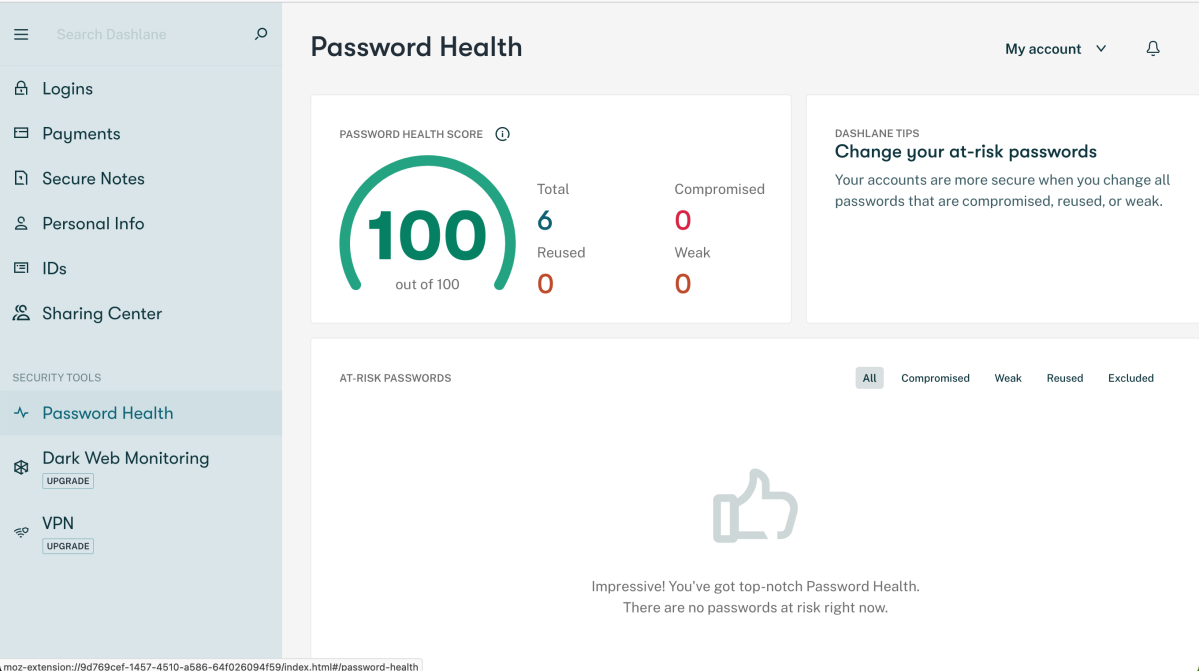 At a Glance
At a GlanceExpert's Rating
Pros
- Analyzes and rates the strength of your passwords
- Supports auto-filling web forms with personal profiles
- VPN and Dark Web scanning available with paid plan
Cons
- Expensive premium tiers
- Free plan limited to one device
Our Verdict
With its strong password analysis and polished interface, Dashlane is one of the best password managers available.
Best Prices Today: Dashlane
Easy to use and rich with features, Dashlane meets all our requirements for a top-tier password manager. But Dashlane goes beyond just managing your login credentials, providing insights for how to think smarter about security.
Dashlane’s strength has long been its elegant web portal interface. A vertical toolbar on the left makes it easy to access your logins, secure notes, payment data, and other information. When you select one of these options, all the associated entries are displayed in the main workspace as tiles or a list. Each tile has its own fly-out menu from which you can view, edit, delete, or securely share that entry.
Dashlane also offers browser extensions for Firefox, Chrome, Edge, Opera, and Safari that offer most of the same capabilities as the portal. I used the Firefox extension, which has four tabs labeled Vault, Autofill, Generator, and More. The Vault tab is where you manage all your saved information, which it organizes into tabs that mirror the toolbar options in the web portal: Logins, Payments, Secure Notes, Personal Info, and IDs. You can manage entries and launch sites directly from the extension. The Autofill tab allows you to turn on or off the ability to automatically fill in the current websites login credentials (at the time of review, this tab included a note that Dashlane will be adding more autofill options soon). The Generator tab allows you to set length and character parameters for auto-generated passwords. These can have between 4 and 40 characters—the default is 16—and include letters, numbers, and symbols. The More tab features options for launching the Dashlane web portal, accessing support articles, and referring a friend to Dashlane in order to get six months free.
Note: See our roundup of the best password managers to learn about competing products, what to look for in a password manager, and product recommendations.

Dashlane’s password generator supports up to 40 characters including letters, numbers, and symbols.
Michael Ansaldo/IDG
One of Dashlane’s most attractive features in previous versions was its security dashboard, which rated the security of each password with a safety percentage as well as one of a half-dozen color-coded descriptions ranging from “Super safe” to “Very unsafe.” That’s been replaced by a Password Health report that provides an aggregate security percentage and shows you only weak, compromised, and reused passwords. For each of these, you can click on a Replace Now button to change them.
At this point Dashlane’s capabilities have caught up with LastPass—while being more secure.
Premium users get a couple of extra features. The first is Dark Web Monitoring, which scans and alerts you to stolen personal data found on the dark web whether the credentials have been used or not. You can associate up to five emails for scanning. Premium users also get a simple VPN for secure Wi-Fi hotspot connections. After an intital setup, you just click VPN from the menu, choose a server location from more than 20 countries, and select Connect. Though any VPN can impact the speed of your internet connection, I didn’t notice any slowdown in my usage.

Dashlane provides a password health score and highlights your most at-risk passwords.
Michael Ansaldo/IDG
Some other password managers let you directly designate an an emergency contact who can access all your information in the even you can’t do it yourself. Dashlane takes a different approach. You can give trusted people access to your Dashlane data by exporting it to a secure DASH file and ideally storing it on a USB drive stored in a safe location like a safety deposit box. You would then share the location of the DASH file and password that protects it with your trusted contact, preferably through a Dashlane secure note, along with instructions on when and how to access it.
Dashlane recently restructured its pricing and now includes four plans. The Free plan offers basic password management—without password limits or sharing restrictions—on a single device. The Advanced plan, which costs $33 annually or $2.75 per month, adds dark web monitoring and enables syncing across all your devices. The Premium account subscription costs $59.88 per year or $4.99 per month and includes all the features of the previous tiers and adds a VPN. The Friends and Family plan extends Premium plans to up to 10 accounts for $89.88 per year or $7.49 per month.
Bottom line
At this point Dashlane’s capabilities have caught up with LastPass. Given LastPass’s recent severe security breach—not its first—it’s easy to recommend Dashlane as the go-to password manager.
Editor’s note: This article was updated to reflect changes in pricing and the addition of Password Health, Identity Dashboard, and VPN features.


